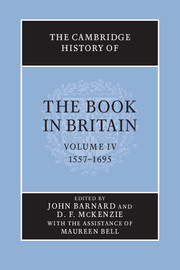Book contents
- Frontmatter
- Dedication
- Contents
- List of illustrations
- List of contributors
- Preface
- Acknowledgements
- Introduction
- RELIGION AND POLITICS
- ORAL TRADITIONS AND SCRIBAL CULTURE
- LITERATURE OF THE LEARNED
- 6 The Latin trade
- 7 Patronage and the printing of learned works for the author
- 8 University printing at Oxford and Cambridge
- 9 Editing the past: classical and historical scholarship
- 10 Maps and Atlases
- 11 The literature of travel
- 12 Science and the book
- 13 Samuel Hartlib and the commonwealth of learning
- 14 Ownership: private and public libraries
- 15 Monastic collections and their dispersal
- LITERARY CANONS
- VERNACULAR TRADITIONS
- THE BUSINESS OF PRINT AND THE SPACE OF READING
- BEYOND LONDON: PRODUCTION, DISTRIBUTION, RECEPTION
- DISRUPTION AND RESTRUCTURING: THE LATE SEVENTEENTH-CENTURY BOOK TRADE
- STATISTICAL APPENDICES
- Abbreviations
- Bibliography
- Index
- Plate Section
- References
14 - Ownership: private and public libraries
from LITERATURE OF THE LEARNED
- Frontmatter
- Dedication
- Contents
- List of illustrations
- List of contributors
- Preface
- Acknowledgements
- Introduction
- RELIGION AND POLITICS
- ORAL TRADITIONS AND SCRIBAL CULTURE
- LITERATURE OF THE LEARNED
- 6 The Latin trade
- 7 Patronage and the printing of learned works for the author
- 8 University printing at Oxford and Cambridge
- 9 Editing the past: classical and historical scholarship
- 10 Maps and Atlases
- 11 The literature of travel
- 12 Science and the book
- 13 Samuel Hartlib and the commonwealth of learning
- 14 Ownership: private and public libraries
- 15 Monastic collections and their dispersal
- LITERARY CANONS
- VERNACULAR TRADITIONS
- THE BUSINESS OF PRINT AND THE SPACE OF READING
- BEYOND LONDON: PRODUCTION, DISTRIBUTION, RECEPTION
- DISRUPTION AND RESTRUCTURING: THE LATE SEVENTEENTH-CENTURY BOOK TRADE
- STATISTICAL APPENDICES
- Abbreviations
- Bibliography
- Index
- Plate Section
- References
Summary
The history of libraries between the mid-sixteenth century and the end of the seventeenth is one not simply of expansion and multiplication, but of changes in the relationships between readers and the book trade, in the ways books were organized, and in the values placed upon them by institutions or individuals. Books – new and old – were neglected as well as welcomed, while Britain became accustomed to using libraries on a scale unimagined at the beginning of our period.
When John Bateman, Fellow of the newly re-founded Gonville and Caius College, Cambridge, died in 1559, the university appraisers valued his goods at £48 17s.1d. He was probably not yet forty years old. His quarters comprised a chamber, an inner chamber, an upper chamber and a study. The chamber contained a table, a desk, sundry chairs and forms, a quantity of clothing, nearly all of it described as ‘old’, but he was well equipped with drinking glasses and table linen. There was also a ‘pair of clavichords’. His inner chamber was his bedroom, with more chairs, two desks and a fireplace. The upper chamber contained a trestle table and eating utensils. The ‘study’ had two chairs, but no free-standing writing surface, a brush, a pen-case and an inkhorn. Here also were found some 500 books. We might perhaps describe the room as his library.
- Type
- Chapter
- Information
- The Cambridge History of the Book in Britain , pp. 323 - 338Publisher: Cambridge University PressPrint publication year: 2002
References
- 2
- Cited by

